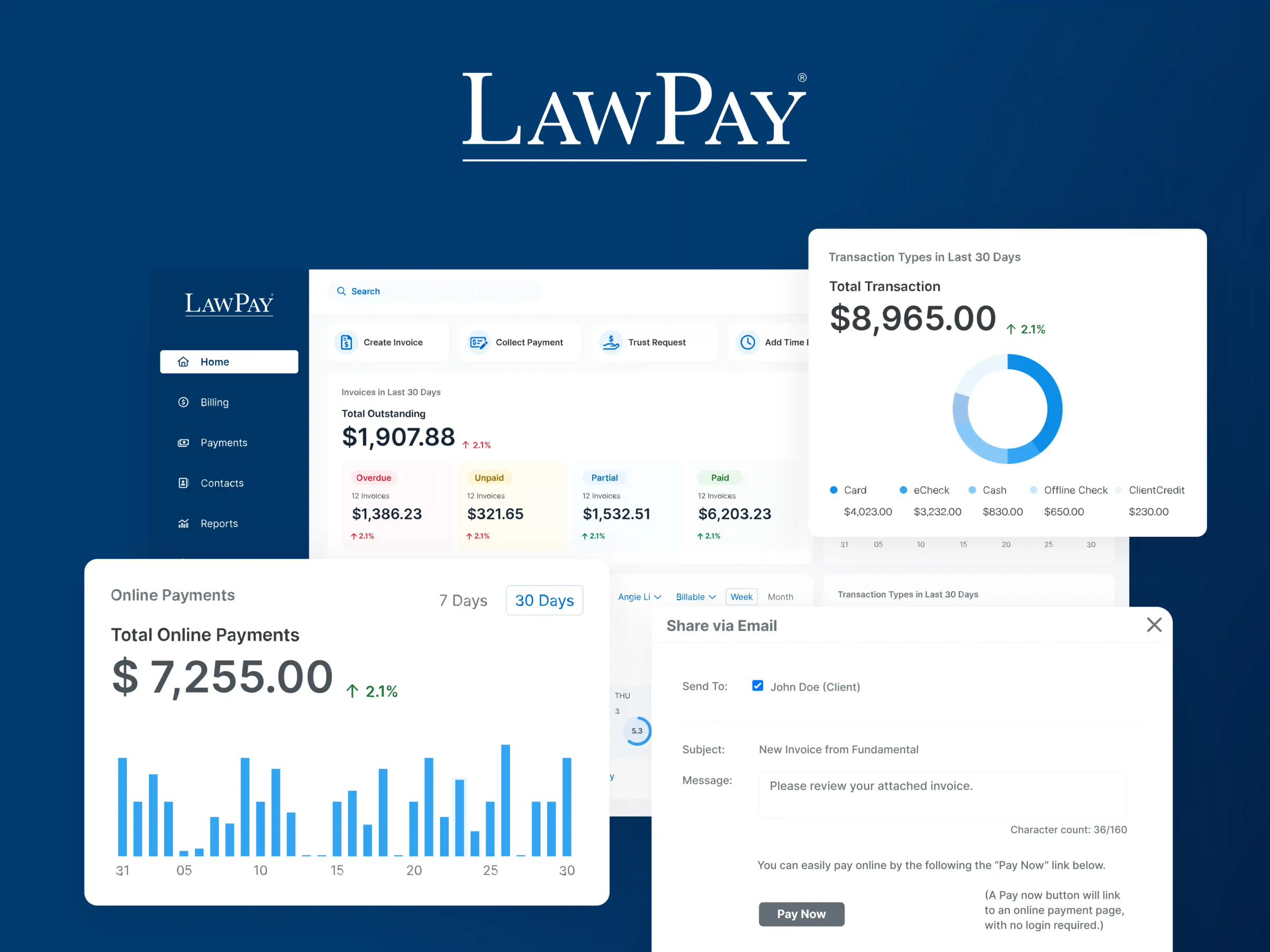Evergreen retainers ensure your law firm gets paid for the work you do. Read on to find out how these fee arrangements work, what their advantages and limitations are, when to use them, and the best practices for implementing this into your firm.
Schedule a demo to see what LawPay can offer your firm.
Book Now
What Is an Evergreen Retainer?
An evergreen retainer is a law firm billing arrangement in which the client pays a sum upfront, the attorney invoices against that sum, and the client tops off the funds whenever the balance reaches a predetermined minimum.
The collected funds are held in a trust account initially. When the lawyer bills for fees earned, the trust account pays the invoice. The payment amount is then transferred out of the trust account and into the firm's operating account. This cycle diminishes the trust account balance over time.
When the trust account balance dips to an agreed-upon minimum, the lawyer asks the client to replenish the funds.
This arrangement is known as an evergreen retainer because the client continues topping off the funds as needed, as long as the relationship is active.
A standard retainer does not include the fund top-off agreement. Instead, when the funds are depleted, the lawyer bills the client at an hourly rate for services provided.
What Are the Advantages of Evergreen Retainers?
We recommend evergreen retainers in our guide, 25 Things I Wish I Learned in Law School, because they're beneficial for lawyers and their clients. Lawyers who use this payment structure experience improved collection rates, happier clients, and reduced risk. Let's explore each of these outcomes in greater detail.
Improved Collection Rate
A properly structured evergreen retainer should always have enough funds to cover the client's next invoice. When you produce that invoice, you don't have to wait for your client to write a check or input a credit card number. You already have the funds on hand.
Naturally, this structure improves your collection rate. Your firm is only reliant on clients actively transmitting money to you when the retainer balance needs replenishment.
Happier Clients
Evergreen retainers benefit your clients, too. For larger projects, an evergreen arrangement allows the client to break up the cost into smaller, more management payments. That's easier than funding all projected fees upfront.
Compared to a monthly invoice with no retainer, evergreen retainers result in more predictable cash outlays for clients. Fees earned one month to the next can vary widely, depending on where a project is in its lifecycle. With an evergreen retainer, the timing of the retainer deposits may fluctuate, but the payment amount will not.
You can also structure your evergreen retainers to align with the natural rise and fall of client motivation. Clients are most motivated to fund your work at the start of the relationship. So, implement larger initial retainer deposits coupled with smaller top-offs. That gives you time to prove your expertise and the value of your services -- before you ask for more money.
Decreased Risk
Collecting payment upfront ensures you are paid for the work you do. If a client's retainer balance dips too low, you can pause work on that case until the retainer is replenished. To avoid any misunderstanding, be sure to outline the consequences of nonpayment in the retainer agreement.
What Are the Limitations to Evergreen Retainers?
Evergreen retainers do have limitations. These arrangements don't work well for smaller projects, for example. If the work has a defined timeline, there's no need for the client to replenish funds continuously.
It also may be harder to manage a client's expectations with an evergreen retainer. Clients must agree upfront to pay for whatever hours you invest in their case, regardless of the result.
The same can happen with hourly billing arrangements, of course. But unhappy clients can choose not to pay for services already performed. You would cease work, but only after you've invested hours in that client for an entire billing period.
When Should Law Firms Consider Using Evergreen Retainers?
Evergreen retainers are appropriate for long, complex cases or ongoing relationships.
Litigation and cases dealing with divorce, conservatorship, personal injury, probate, and criminal charges can take months or years to resolve. In these situations, clients probably can't or don't want to fund a full retainer upfront. The evergreen arrangement eases their payment burden and ensures payment for services provided.
Best Practices for Law Firms Using Evergreen Retainers
There are processes you can implement to manage your evergreen retainer clients smoothly. Four critical practices are outlined below: structure the arrangement thoughtfully, document the terms, use technology to monitor the retainer balances closely, and communicate with your clients.
Structure the Arrangement Thoughtfully
The upfront payment and top-off amounts should reflect the complexity of the case. You want to avoid depleting the retainer below the minimum and then below zero in the middle of a billing period.
In that scenario, you would need to request additional retainer funds. And, you would need to invoice for the fee overrun. To clients, this can appear to be double billing. That's likely to prompt questions and, possibly, introduce doubt about legitimacy of your billing process.
You can minimize mid-month overruns by structuring the agreement properly and estimating how much your legal services will cost. An adequate initial payment and an appropriately sized top-off amount are critical.
Document the Terms in a Written Agreement
Drafting fee agreements that are comprehensive and detailed is no small task. You'll want to include information on the scope of work, invoicing and retainer replenishment process, payment terms, consequences of nonpayment, and dispute resolution.
Scope of Work
Describe the case and the services you will perform.
Invoicing and Retainer Replenishment Process
Explain how the retainer funds are held in trust, and then used to pay invoices. Highlight the retainer balance reconciliation included on your invoices.
Also describe how and when you'll ask the client to replenish the retainer, including the minimum balance that will trigger the funds request.
Payment Terms
Define the payment terms for balance-due invoices and retainer funds requests. Describe situations in which the client may see a balance-due invoice for services, such as a midmonth retainer overrun. Include any interest accrual you will charge on past-due amounts.
Consequences of Nonpayment
Be sure your client understands how you address nonpayment of retainer requests. Document when you will pause work and what is required for you to restart.
Dispute Resolution
Explain how you'd like disputes to be resolved. Arbitration or mediation are the usual options.
Using Legal Software Built for Trust Accounting Compliance
You need a failsafe system in place to monitor retainer balances. Ideally, you should know before a retainer reaches its minimum balance -- not after. This is critical, because failing to send timely requests for additional retainer funds undermines the whole system.
Legal billing technology is the simplest and most reliable answer for monitoring retainer balances. The right legal software keeps your evergreen retainers functioning and ensures compliant handling of unearned funds.
Communicate with Clients
Regular communication with your clients about invoicing and retainer funds is important. You don't need to host a detailed billing discussion every month, but you should send invoices regularly and request feedback.
Send Invoices
Invoices are more than billing documents. They also detail the services you have provided. Clients should be able to review the invoice, understand what you're doing, and recognize the value of that work.
If the balance is paid by the retainer funds, note that clearly on the invoice. Also show the starting and ending retainer balances. This way, clients who review your invoices should not be surprised when it's time to replenish the retainer balance.
Ask for Feedback
Asking for feedback will help you refine your evergreen retainer structures and documentation. Check in with clients formally or informally to get their thoughts on how the process is working for them. You don't have to implement every suggestion offered, but you should note them. If you get several similar requests, that's your cue to consider a process change.
Final Notes
Evergreen retainer arrangements can reduce risk for you and ease budgeting for your clients. You get a reliable payment source for services performed, and your clients can break up a large fee into more manageable segments. These evergreen arrangements are most appropriate for complex cases that continue for several months or years.
Schedule a demo to see what LawPay can offer your firm.
Book Now
For the evergreen retainer system to work, you must have a reliable mechanism for tracking retainer balances. And, you must handle client retainer balances in compliance with state bar guidelines.
Fortunately, you can check off both requirements with the right legal software.
LawPay supports IOLTA-compliant electronic billing for lawyers. Use it to manage evergreen retainers, as well as fee payments, installments, and recurring payments. With its robust electronic billing, your clients can easily fund retainers or pay fees via credit card, debit card, or eCheck -- through a link or QR code. Funds held in trust are automatically kept whole until amounts are earned and invoiced.
Even better, LawPay continually tracks retainer balances and alerts you when a client's funds are running low. Billing and payments with LawPay are vastly more efficient -- and safer from a compliance perspective -- than manual systems. Contact us today to find out how LawPay can streamline accounting for all your clients, including those on evergreen retainer agreements.
About the author

Catherine Brock
